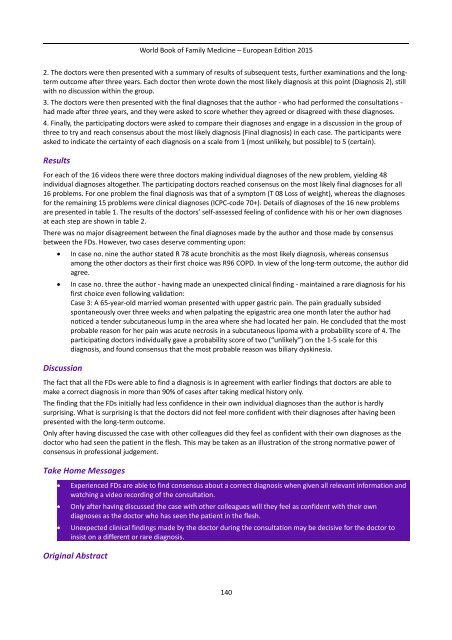Family Medicine
World Book 2015
World Book 2015
You also want an ePaper? Increase the reach of your titles
YUMPU automatically turns print PDFs into web optimized ePapers that Google loves.
World Book of <strong>Family</strong> <strong>Medicine</strong> – European Edition 2015<br />
2. The doctors were then presented with a summary of results of subsequent tests, further examinations and the longterm<br />
outcome after three years. Each doctor then wrote down the most likely diagnosis at this point (Diagnosis 2), still<br />
with no discussion within the group.<br />
3. The doctors were then presented with the final diagnoses that the author - who had performed the consultations -<br />
had made after three years, and they were asked to score whether they agreed or disagreed with these diagnoses.<br />
4. Finally, the participating doctors were asked to compare their diagnoses and engage in a discussion in the group of<br />
three to try and reach consensus about the most likely diagnosis (Final diagnosis) in each case. The participants were<br />
asked to indicate the certainty of each diagnosis on a scale from 1 (most unlikely, but possible) to 5 (certain).<br />
Results<br />
For each of the 16 videos there were three doctors making individual diagnoses of the new problem, yielding 48<br />
individual diagnoses altogether. The participating doctors reached consensus on the most likely final diagnoses for all<br />
16 problems. For one problem the final diagnosis was that of a symptom (T 08 Loss of weight), whereas the diagnoses<br />
for the remaining 15 problems were clinical diagnoses (ICPC-code 70+). Details of diagnoses of the 16 new problems<br />
are presented in table 1. The results of the doctors’ self-assessed feeling of confidence with his or her own diagnoses<br />
at each step are shown in table 2.<br />
There was no major disagreement between the final diagnoses made by the author and those made by consensus<br />
between the FDs. However, two cases deserve commenting upon:<br />
<br />
<br />
Discussion<br />
In case no. nine the author stated R 78 acute bronchitis as the most likely diagnosis, whereas consensus<br />
among the other doctors as their first choice was R96 COPD. In view of the long-term outcome, the author did<br />
agree.<br />
In case no. three the author - having made an unexpected clinical finding - maintained a rare diagnosis for his<br />
first choice even following validation:<br />
Case 3: A 65-year-old married woman presented with upper gastric pain. The pain gradually subsided<br />
spontaneously over three weeks and when palpating the epigastric area one month later the author had<br />
noticed a tender subcutaneous lump in the area where she had located her pain. He concluded that the most<br />
probable reason for her pain was acute necrosis in a subcutaneous lipoma with a probability score of 4. The<br />
participating doctors individually gave a probability score of two (“unlikely”) on the 1-5 scale for this<br />
diagnosis, and found consensus that the most probable reason was biliary dyskinesia.<br />
The fact that all the FDs were able to find a diagnosis is in agreement with earlier findings that doctors are able to<br />
make a correct diagnosis in more than 90% of cases after taking medical history only.<br />
The finding that the FDs initially had less confidence in their own individual diagnoses than the author is hardly<br />
surprising. What is surprising is that the doctors did not feel more confident with their diagnoses after having been<br />
presented with the long-term outcome.<br />
Only after having discussed the case with other colleagues did they feel as confident with their own diagnoses as the<br />
doctor who had seen the patient in the flesh. This may be taken as an illustration of the strong normative power of<br />
consensus in professional judgement.<br />
Take Home Messages<br />
<br />
<br />
<br />
Experienced FDs are able to find consensus about a correct diagnosis when given all relevant information and<br />
watching a video recording of the consultation.<br />
Only after having discussed the case with other colleagues will they feel as confident with their own<br />
diagnoses as the doctor who has seen the patient in the flesh.<br />
Unexpected clinical findings made by the doctor during the consultation may be decisive for the doctor to<br />
insist on a different or rare diagnosis.<br />
Original Abstract<br />
140


